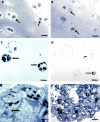Beta irradiation decreases collagen type II synthesis and increases nitric oxide production and cell death in articular chondrocytes
- PMID: 14583567
- PMCID: PMC1754347
- DOI: 10.1136/ard.62.11.1054
Beta irradiation decreases collagen type II synthesis and increases nitric oxide production and cell death in articular chondrocytes
Abstract
Background: When synovitis is proved, intra-articularly injected beta emitting radionuclides like yttrium-90 ((90)Y) are used to treat the inflamed synovium.
Objective: To study the viability, matrix production, and NO production during or after (90)Y treatment of chondrocytes.
Methods: Monolayer, alginate, and explant cultures of primary bovine articular chondrocytes as well as synoviocytes were incubated with 0-3 MBq (90)Y/ml medium for four days from culture day 3 onwards. Cell viability was demonstrated by light and electron microscopy or by trypan blue or ethidium bromide/fluorescein diacetate staining, membrane integrity by measurement of lactate dehydrogenase (LDH) activity in the culture supernatants. Biosynthetic activity was demonstrated by incorporation of [(3)H]proline and immunocytochemical staining of collagen type II. NO production was measured with the Griess reagent.
Results: In chondrocyte and synoviocyte monolayer cultures radiation caused a dose dependent increase in cell death and membrane destruction within four days. In alginate and explant cultures, where proliferation is low, no significantly increased LDH activity was seen, and cell viability was approximately 100% for up to 14 days after irradiation. Collagen type II expression (alginate) and biosynthetic activity (alginate and explants) were decreased dose dependently while there was an increase in NO production. Light and electron microscopy data showed that five weeks after irradiation all cells in alginate and most cells in explants subjected to 3 MBq (90)Y/ml were dead, whereas after lower amounts of irradiation several morphologically intact cells were found.
Conclusions: beta Irradiation may influence the long term maintenance of cartilage tissue or the aetiology of degenerative joint diseases.
Figures




Similar articles
-
Redifferentiation of dedifferentiated bovine articular chondrocytes in alginate culture under low oxygen tension.Osteoarthritis Cartilage. 2002 Jan;10(1):13-22. doi: 10.1053/joca.2001.0477. Osteoarthritis Cartilage. 2002. PMID: 11795979
-
Perfusion culture system: Synovial fibroblasts modulate articular chondrocyte matrix synthesis in vitro.Tissue Cell. 2010 Jun;42(3):151-7. doi: 10.1016/j.tice.2010.03.003. Epub 2010 Apr 28. Tissue Cell. 2010. PMID: 20427066
-
High glycine concentration increases collagen synthesis by articular chondrocytes in vitro: acute glycine deficiency could be an important cause of osteoarthritis.Amino Acids. 2018 Oct;50(10):1357-1365. doi: 10.1007/s00726-018-2611-x. Epub 2018 Jul 13. Amino Acids. 2018. PMID: 30006659 Free PMC article.
-
Glucan HBP-A increase type II collagen expression of chondrocytes in vitro and tissue engineered cartilage in vivo.Chin J Integr Med. 2015 Mar;21(3):196-203. doi: 10.1007/s11655-013-1511-x. Epub 2013 Jul 16. Chin J Integr Med. 2015. PMID: 23860800
-
Effects of shear stress on articular chondrocyte metabolism.Biorheology. 2000;37(1-2):95-107. Biorheology. 2000. PMID: 10912182 Review.
Cited by
-
Effects of low dose X-ray irradiation on porcine articular cartilage explants.J Orthop Res. 2013 Nov;31(11):1780-5. doi: 10.1002/jor.22406. Epub 2013 Aug 1. J Orthop Res. 2013. PMID: 23913833 Free PMC article.
-
The effects of low-dose radiation on articular cartilage: a review.J Biol Eng. 2019 Jan 7;13:1. doi: 10.1186/s13036-018-0125-4. eCollection 2019. J Biol Eng. 2019. PMID: 30627214 Free PMC article. Review.
-
Failed septal extension graft in a patient with a history of radiotherapy.Maxillofac Plast Reconstr Surg. 2016 Oct 25;38(1):40. doi: 10.1186/s40902-016-0086-9. eCollection 2016 Dec. Maxillofac Plast Reconstr Surg. 2016. PMID: 27830140 Free PMC article.
-
Recurrent Hemarthroses After TKA Treated With an Intraarticular Injection of Yttrium-90.Clin Orthop Relat Res. 2016 Mar;474(3):850-3. doi: 10.1007/s11999-015-4217-x. Epub 2015 Feb 25. Clin Orthop Relat Res. 2016. PMID: 25712866 Free PMC article.
-
Genotoxic stress accelerates age-associated degenerative changes in intervertebral discs.Mech Ageing Dev. 2013 Jan-Feb;134(1-2):35-42. doi: 10.1016/j.mad.2012.11.002. Epub 2012 Dec 19. Mech Ageing Dev. 2013. PMID: 23262094 Free PMC article.
References
Publication types
MeSH terms
Substances
LinkOut - more resources
Full Text Sources

